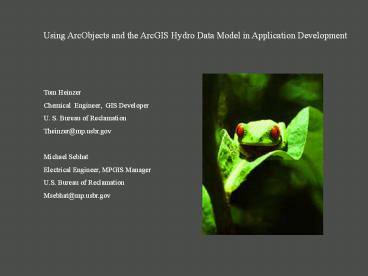Using ArcObjects and the ArcGIS Hydro Data Model in Application Development - PowerPoint PPT Presentation
1 / 11
Title:
Using ArcObjects and the ArcGIS Hydro Data Model in Application Development
Description:
Using ArcObjects and the ArcGIS Hydro Data Model in Application Development Tom Heinzer Chemical Engineer, GIS Developer U. S. Bureau of Reclamation – PowerPoint PPT presentation
Number of Views:200
Avg rating:3.0/5.0
Title: Using ArcObjects and the ArcGIS Hydro Data Model in Application Development
1
Using ArcObjects and the ArcGIS Hydro Data Model
in Application Development
Tom Heinzer Chemical Engineer, GIS Developer U.
S. Bureau of Reclamation Theinzer_at_mp.usbr.gov Mic
hael Sebhat Electrical Engineer, MPGIS
Manager U.S. Bureau of Reclamation Msebhat_at_mp.usbr
.gov
2
The birth of ESRIs COM based data environment is
having a profound impact on application design
and development. Not only are the components that
make up the applications graphical user
interface COM based, but the fundamental
geometric objects themselves adhere to the COM
specification. This new environment has created
many new opportunities for all of us, most of
which are yet to be realized. Most of us GIS
practitioners that are grappling with VB, C,
COM, VISIO, UML , repositories and so forth
certainly find it a non-trivial endeavor. It has
become clear, however, that exploring the
benefits of this technology are well
worthwhile. The ArcGIS Hydro Data Model is an
excellent example of extending ESRIs general
data model to a refinement that better suits the
needs of a specific niche, in our case modeling
hydrodynamic systems. The application that
follows is an example of extending that data
model even further to fit the needs of a specific
modeling system- the Danish Hydraulic Institutes
MIKE11. Most classes of the DHI data model
inherit from the ArcGIS data model. In this
application, we use ArcObjects programming to
interact with the extended geodatabase.
Additionally, we attempt to show some current
research in the area of mapping one dimensional
solution spaces into two dimensions. The methods
we utilize require user interaction to modify a
TIN structure which represents a water surface at
a given time. Dynamic TIN editing is facilitated
using Arc Objects code. ArcObjects techniques
are also used to update the water depth raster
layers every time the TIN surface is modified.
This is mainly facilitated by the ITinEdit and
IPixelBlock COM interfaces. The following slides
attempt to illustrate the procedure.
3
Research on Direct Connectivity Between MIKE11
Cross Section Editor and Arc8 Hydro Model
The MIKE11 GUI.. A transect has been added to the
terrain model, which has sampled the digital
elevation model and stored the information in the
DHI Hydro Model database. If the transect is
deleted, the associated data in others tables are
deleted (cascading deletes) because of the
composite relationships built into the data model
using UML.
4
When the cross section editor tool (red circle)
is used on a cross section (blue transect), an
ActiveX control is notified to appear. It is also
passed the cross sections feature ID. The code
in the control subsequently searches the hydro
data model table where the elevation profile data
is stored (XSectionPoints) and loads the data
into the graphing and table components
5
This is an example of placing a different
graphing ActiveX control (one that ESRI supplies
with ArcGIS) into ArcMap and pointing it at the
geodatabase as in the previous slide. All
functionality of the embedded control is present,
and it is docked within the ArcMap framework.
Also present is a dockable web browser in the
framework. This is all possible because of the
COM compliance and proper interface
implementations. The upper floating toolbar is
generated on the fly using ArcObjects code
(ICommandBar).
6
Theory
Mike11 is a 1D model which solves for a water
surface at a given time along a river line. To
map inundation, one generally compares the water
surface with the underlying elevation model.
Getting the water surface properly represented in
two dimensions can be problematic.
7
Thin Delaunay Triangles in an exaggerated
elevation model view.
The transects which generate the cross sections
are densified and added to a TIN using the
ITinEdit interface. This enforces a thin triangle
formulation which ensures a relatively flat
planar surface between transects and adds
interpolation control.
8
Manipulation of TIN Surface to Modify Inundation
Surface Arc Objects Procedures
The idea here is to attempt to map inundation
given water levels at all of the model solution
points. The densified transects are placed into a
tin structure and mapped. Inundation, along with
water depths are mapped at once, however, some of
the areas that appear inundated are incorrect due
to the configuration of the TIN structure. This
can occur where triangles jump across U shaped
areas, or where the TIN doesnt happen to cover
an area that should be inundated (even though it
isn't modeled-ie at a cross section). We use
manual inspection at this point.
9
Modification of Inundation Surface with Dynamic
Tin Editing
Interpolation Transects
Erased
Additional interpolation transects are added to
modify the TIN. These new mapping transects take
their values either from other solution points
(white) or other transects. Areas can also be
erased. The water depths update accordingly in
the modified areas
10
Hard Polygon Erasure and Interpolation Transects
powered by ArcObjects
Hard Break Line
The interactive methods allow the user to map
small offline areas in an understandable, and
usually defensible way, even if it isn't perfect.
11
Ending Slide. ArcObjects animator visualizing a
MIKE21 (2D) simulation. This is a still. 130 Cad
drawings, 2 ft contours with building footprints
and heights.































